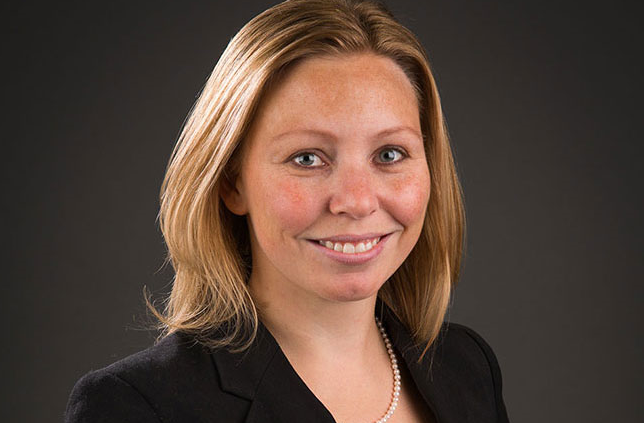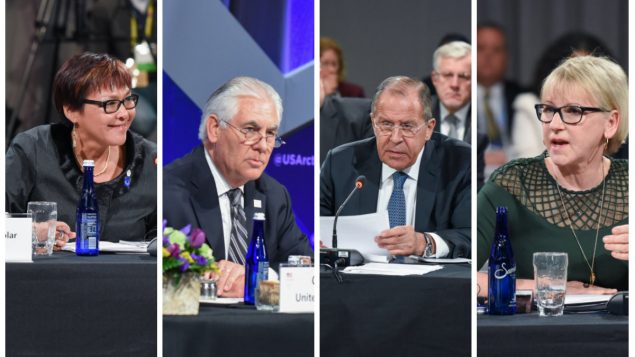Eye on the Arctic brings you stories and newsmakers from across the North
For our 2017 Arctic news roundup series, we checked in with some of our expert bloggers, for their take on this year’s Arctic news: what the media got right, what we got wrong and what might be important to keep our eye on in 2018.
Today, in the last instalment of our series, we’re joined by Heather Exner-Pirot. She’s a managing editor at the Arctic Yearbook , a peer-reviewed publication devoted to the North, and her work appears regularly on Eye on the Arctic.

Heather Exner-Pirot, a managing editor at the Arctic Yearbook. (Courtesy Heather Exner-Pirot)
Eye on the Arctic: Good, bad, bumbling or benign – how would you sum up general Arctic news coverage in 2017?
Heather Exner-Pirot: All of those at different times.
Having the U.S. as Arctic Council chair brought a lot of really great coverage to Arctic politics – we’ve never seen that amount and quality. But at the same time, some of the usual tropes were brought out. We’re just coming off of the viral skinny polar bear story, which in itself, kind of shows the struggle you’re up against when you’re trying to cover the Arctic effectively. (The video) was very emotional, very shareable, and it was used for various environmental and climate change agendas without a lot of Inuit voices or Inuit perspectives. So those are the kinds of challenges you see (in Arctic news coverage). 2017 was no different.
Also, one of the challenges of Arctic news coverage is that for a mainstream audience they’re really interested in the polar bears and the climate change, but for local Arctic audiences it’s the usual coverage of local politics, crime and the mom and pop stories. We had two Arctic-focused media, Arctic Deeply and Arctic Journal, close down this year. I think it’s hard to find that middle ground audience that is knowledgeable about the Arctic but that looks at it from a more global perspective. In the end, I guess they didn’t find that audience.
What were your two most important Arctic stories of the year?
The Arctic Council ministerial in Fairbanks, Alaska and the commercial fishing ban agreement in the Central Arctic Ocean.
These two stories don’t make the front pages but they’re so important. Even during this very tense time between Russia and the West – with interference in elections, topsy-turvy American politics – despite all the crazy things happening everywhere else, the Arctic is still so resilient – and finds ways to cooperate.
The Arctic Council ministerial was the first time all eight Arctic foreign ministers came together. They all talked about the importance of this cooperation. They all talked about about how the Arctic is different and they’re going to keep it different and how it’s in everyone’s interest to keep it different.
That’s remarkable. You didn’t see that a lot anywhere else in 2017.
We saw the same kind of progressiveness in the Central Arctic Ocean fishing agreement It’s the precautionary principle. It’s including non-Arctic states with Arctic states. It’s thinking ahead. It’s working between the United States and Russia, Russia and China. There’s so many dynamics but still the deal got done. It’s almost a miracle, but there’s still place in the world where countries are acting responsibly, diplomatically and professionally and in the interests of the common good.
U.S. involvement in the Arctic Council seems remarkably untouched by the chaos we’ve seen elsewhere under the Trump administration – what gives?
A year ago I was as nervous as everyone else that the Trump administration could unsettle the Arctic Council, that twenty years of hard work could be toppled. But that didn’t happen.
I think one reason is that the Trump administration, and Trump in particular, doesn’t know much about the Arctic and doesn’t care much about the Arctic. The Arctic Council was able to fly under the radar which I think was a very good thing.
The other thing is that Alaska is America’s Arctic. Even under Obama and Kerry, Alaska had a lot of influence on the Arctic Council. So even though the White House changed from Democrat to Republican – Alaska still had the same interests and those interests roughly align with Trump’s domestic and economic agenda. So the fact that there was continuity in Alaska politics, and Alaskan interests, really contributed to the stability.
Was there any Arctic issue or event that you felt was overlooked, underreported – or that you feel just didn’t get the attention it deserved in 2017?
About this time last year, Canadian Prime Minister Justin Trudeau and U.S. President Barack Obama put a moratorium on offshore Arctic drilling. This infuriated northerners in Canada and I don’t think it got enough attention. Politicians and leaders up north are still mad about it and I think it’s going to pose problems when we talk about reconciliation and the new Arctic Policy Framework because there’s this underlying tension. On the one hand your saying one thing, on the other hand you’re doing the other.
The premier of the Northwest Territories, Bob McLeod issued a red alert – that’s what they called it – to call for an urgent national debate on the future of the Northwest Territories. Those are not typical political messages – this is very serious for them.
I think it’s also part of, not only the relationship between the federal government and the territories, but also emblematic that there’s still some tension between the territories and the Indigenous organizations within the territories. And who are the partners for the federal government? Can the federal government make deals with Inuit Tapiriit Kanatami, Canada’s national Inuit organization, on environment protection, without making them with Nunavut, or Nunavik or Nunatsiavut?
So the relationships between different layers of government – Who governs? Who’s responsible? – I think we saw this year it’s still very much in flux
When it comes to Arctic news, what will you be watching for in 2018?
There’s not a lot on the horizon from an international political perspective – there’s no agreements coming out, it will be a quiet year.
But Canada is preparing an Arctic Policy Framework that’s going to combine domestic and foreign elements, which is something new and different. I’m very curious. What’s it going to look like? How are they going to combine the different elements? What will Canada’s focus be?
And in the bigger picture, where is Arctic foreign policy going? Since 2007 when we had the Russian flag planting on the North Pole, then-Canadian Prime Minister Stephen Harper said ‘Use it or lose it,’ and oil and gas spiked, we’ve kind of been in this particular phase of Arctic foreign policy. What’s going to replace it?
When we see the new Arctic Policy Framework, I’m hoping that Canada takes some leadership on setting the stage for what we’re going to do for the next ten years.
The above Q&A has been edited and abridged.
Listen to the full Eye on the Arctic interview with Heather Exner-Pirot:
Write to Eilís Quinn at eilis.quinn(at)cbc.ca








For reasons beyond our control, and for an undetermined period of time, our comment section is now closed. However, our social networks remain open to your contributions.